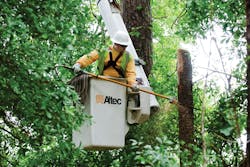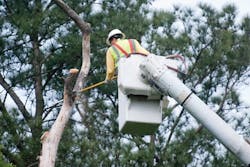Proactive Approach Boosts Reliability in Texas
In the transmission and distribution industry, aging infrastructure can lead to widespread outages and costly replacements. Compounding this problem, weakened trees can fall onto power lines, inflicting severe damage and posing a hazard to both linemen and customers.
To address both of these issues, Entergy Texas takes a proactive rather than reactive approach to both its pole maintenance and vegetation management programs. The utility partners with contractors to inspect and maintain the wood poles in its system as well as to manage the vegetation surrounding the feeders in its service territory. Through pre-planning, consistent inspections and prompt response times, the utility is able to keep its poles and lines in working condition and minimize power disruptions to its customers.
Maintaining Wood Poles
As at many other electric utilities, Entergy’s linemen are tasked with maintaining aging wood poles. These poles can be susceptible to everything from woodpecker attacks to termite infestations. Over time, however, wood pole manufacturers have begun treating their poles with preservatives to ward off harmful termites and prevent them from eating the inside or outside of wood poles.
Linemen also can extend the lifetime of a wood pole by filling woodpecker-caused cavities with special expanding polymer-concrete products like IPOLE-WPK Woodpecker Hole Repair from Underground Material Solutions. The foam can expand to twice its size and penetrate through any decay to bond to the undecayed wood. After it is cured, it can flex and move without separating from the wood, which is important during high winds. Also, the filler has as an odor that repels woodpeckers but is not noticeable to humans. The foam also features micro-
encapsulated bursts so that the odor is released when the woodpecker pecks into the repaired area on the pole. This odor will then last for an extended period of time.
To use the foam, the linemen combine the two parts within the plastic pouch, creating a quart-sized amount of foam. The user kneads the bag to blend the ingredients, then cuts the corner of the pouch and squeezes the product into the void. The epoxy is available in both 1-lb and 3-lb kits, and comes in both a summer and winter
formula.
In addition to battling woodpecker holes, Entergy Texas also confronts wood rot with poles. Wood poles can rot from the inside, breaking down the wood’s cellular structure, removing material from the wood and weakening the pole.
Both dry rot and wet rot can inflict severe damage to wood poles, forcing utilities to replace them. Wet rot can occur when water collects at the bottom of a wood pole and moisture enters the wood, causing it to rot at the ground line.
To maximize reliability and minimize outages, Entergy has a proactive plan to inspect the poles in the utility’s service territory. Distribution designers, linemen, servicemen and other employees also conduct pole inspections as part of their normal course of job duties each day.
Through its partnership with Osmose Utility Services Inc., the utility can pinpoint problem poles and restore or replace them before they cause a problem. During these inspections, an Osmose employee takes a close look at the pole’s condition at the ground line. Next, he or she knocks on the pole with a hammer and listens for hollow sounds. If necessary, the inspector will bore into the pole to determine how much of the pole is left and the strength of the pole. A rotted pole will be replaced.
Removing Danger Trees
Another way Energy is improving reliability is through its vegetation management program. In particular, the utility keeps a watchful eye on dead or dying trees, called “danger trees,” which can fall onto power lines and inflict damage to poles. These trees also can damage property and pose danger to the public.
In Orange County, Texas, the utility maintains 45 feeders and tries to inspect them at least twice a year due to the growing cycle. The linemen and foremen also look out for danger trees and alert Entergy’s vegetation management team.
If a certain feeder or device has had repeated reliability issues, Entergy will “hot spot” the feeder if it is not already scheduled to be cycle trimmed. That means the feeder will be patrolled for danger trees and any other potential trouble areas, which are then trimmed to mitigate any future reliability issues.
Because of recent drought conditions in Texas, even trees that are green and healthy one day may deteriorate to danger trees the next. For that reason, it’s imperative for Entergy’s field workforce to help identify these trees before they become a problem.
At Entergy, the feeders are trimmed on a regular rotation every four to seven years. The trim cycle is dictated by the growth pattern of the trees. For example, some trees are hardy while others, such as pines, tend to be more finicky and are more susceptible to the elements and disease.
Often, however, the utility discovers a danger tree after an outage on the system. If an outage is reported, then the vegetation management team reviews the data and will inspect the area to avoid other potential outages.
To remove the danger tree, the arborists have myriad methods they can implement. They can use ground crews and bucket trucks to remove danger trees close to poles and lines, but occasionally other tools such as cranes are necessary. The company partners with ABC Professional Tree Service to perform all of the cycle trimming as well as the reactive work.
Employing Other Vegetation Management Methods
Entergy not only regularly inspects its poles and removes danger trees from harming its feeders, but also relies on other techniques to keep its rights-of-way clear and safe. For example, to treat the smaller underbrush, Entergy and its contractor use chemical spraying. Removing the small underbrush before it gets entangled in the line pays long-term dividends because they don’t have to cut a big tree but can manage it while it’s still relatively low to the ground. This spraying technique can be more cost-effective than the manually intensive hand cutting.
The utility also uses a mechanical tree saw from Jarraff Industries, which can cut down everything in its path. A tractor pulling a bush hog runs over the remaining limbs, creating mulch and a clean right-of-way. The machines create so much noise that Entergy only allows their use in more secluded or remote areas, rather than in residential neighborhoods.
By working with Edko LLC, a vegetation management company, Entergy is also able to implement a tree growth regulator (TGR) program. For the TGR program, the arborists inject the chemicals into the tree and it modifies the trees on a cellular level so they divide at half the rate, which slows the tree’s growth.
For the trees that are already full grown, the vegetation management professionals trim the trees in the healthiest way possible to minimize its chance of mortality. All vegetation management contractors must be trained on how to trim trees based on international arboricultural standards before even setting foot on Entergy’s property. When working with contractors, Entergy has stressed the importance of safety to the point that important job safety analysis documents have been translated into Spanish to ensure understanding by as many contractors as possible. If the crews work safely and according to contract specifications, the job gets done correctly and all parties are happier in the end.
Dealing with Tree Mortality
Despite their best attempts at proactive tree trimming and maintenance, some of the trees in Entergy’s service territory are facing early mortality due to drought and the pine beetle. The pine beetle is one of the biggest killers of damaged of weakened pine trees in the Piney Woods region of eastern Texas.
Unfortunately, the drought and pine beetles have leveled a damaging one-two punch. As drought weakens the trees, the pine beetles then infest them and speed their death. Fortunately, like many other types of pests, pine beetles typically don’t infect the stronger trees surrounding the infected tree, but rather move to another location.
Entergy forecasts that it will see the effect of the drought for years to come. Even after conditions return to normal, drought-related stress will cause irreparable damage that can last into the future.
Since the drought affected many species of trees in Entergy’s service territory, the utility encourages homeowners to cut down trees that are showing signs of weakness before they pose a danger. This should only be done, however, if it can be done safely and in compliance with federal and state laws associated with working near power lines.
Identifying issues with poles and lines before they become critical problems is a key part of Entergy Texas’ efforts to provide safe, reliable power for its customers. By doing taking this proactive approach to maintenance, the Texas utility has been able to limit these issues.
Adam Duncan ([email protected]) is the supervisor of work management for Entergy Texas Inc. He manages all of the company’s proactive maintenance-type activities from scheduling infrared inspections to pole maintenance.
Brian Garcia ([email protected]m) is operations coordinator in Orange County for Entergy Texas Inc.’s vegetation management group.


